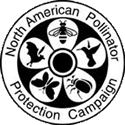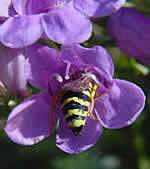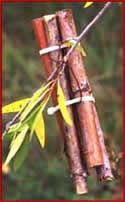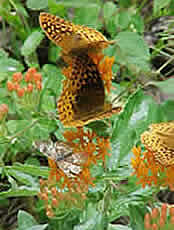USDA Forest Service Celebrating Wildflowers
|
|
|
Pollinator Friendly Practices North American Pollinator Protection Campaign (NAPPC)About Pollinator Friendly Practices (PFP)The guidelines outlined in this document are to be used by organizations in support of land management practices in schools, private industry, public spaces, agriculture, forests, and homes. The guidelines are meant to augment existing land use incentives and to be used by organizations, both those affiliated with NAPPC and others, in educating about and promoting pollinator friendly land use practices. These were developed in concert with the Wildlife Habitat Council. PFP GuidelinesThe NAPPC Pollinator Friendly Practices Guidelines consider six different areas of land use management: Foraging Habitat, Reproduction, Shelter, Invasive/Exotic Species, Chemical Use, and Monitoring. For each topic, there is a central question to be addressed followed by a detailed approach to the subject. Foraging HabitatEnsure sufficient foraging habitat for pollinators, including plant species of high value. Cultivate native plants that may serve as sources of nectar, pollen for adult pollinators, or larval host plants, and which have flower shapes that are accessible to the pollinators that you would like to attract. Deep or complex flowers may be suited to specific species, such as lupines and bumblebees. Open flowers like asters are easily accessible to a wide range of bees with short tongues or small size, as well as flies and beetles. Try to ensure that there is continuous bloom through early spring through fall, and cluster plantings, if possible. ReproductionReproduction considerations depend on the needs of the pollinating species for which the land is being managed. For specific butterfly and moth species, appropriate larval host plants should be used. For native bees, sufficient ground nesting areas, snags, or bee blocks, should be available. For hummingbirds and doves sufficient nesting habitat should be present, whereas bats will require sufficient roosting and maternity habitat. Reproduction habitat requirements may vary. For example, specific nesting requirements are not well established for many species of native bees. For native bee conservation, general principles should be considered, such as:
Habitat connectivity is another important concept in habitat planning that should be considered, due to high fragmentation in many regions. For a bee, both nesting and foraging habitat should be close together to benefit the most species and provide optimum conditions. ShelterProvide shelter in the form of windbreaks, specific plantings, and overwintering areas. Shelterbelts could provide nesting sites for hummingbirds as well as bees, such as snags, and additional nectar and pollen sources (maples, wild cherries, linden, etc.). Such areas will also provide cover for butterflies in windy conditions and adverse weather. Since foraging areas should be in the sun early in the season, the position of nesting sites needs to be planned carefully in relation to trees or shelterbelts. Certain species may have specialized shelter needs that need to be considered. For example, exposure to sun at appropriate times of day ensures the success of bee nesting sites. For wood nesting species, the nesting blocks need sun on the holes in the morning and not in the afternoon. Bumblebees prefer partial shade for nesting. Most ground nesting sites should be south facing, so they get the sun for more of the day. Chemical UseUse Integrated Pest Management. Integrated pest management is a critical component of safe habitat for pollinators. Pesticides should not be used, if possible, but some are more hazardous to pollinators, depending on active ingredient. Chemical use considerations:
Some chemicals can be used for the benefit of pollinators, such as in fire ant control and restoration projects; this use should be considered only when appropriate. Herbicides should only be used during the site preparation and establishment phase when there is no feasible alternative. Herbicides should not be used during management if there is an alternative, and if used only for careful spot treatment. Emphasis must be on a thoughtful, educated approach to chemical use, and to a reduction and ultimate elimination of its use. MonitoringMonitor the site over time with pollinator inventories and note changes such as pollution and other habitat effects. Though scientific counts are preferred, simple observation such as notes on the number of floral visitors to a patch per 10 minutes, monitored usage of bee blocks, etc., are acceptable and encouraged. |
|
| NOTE: PDF format links require the Adobe Acrobat Reader to view. | |
| top | Disclaimers | FOIA | Privacy Policy | Quality of Information | Photo Credits & Use |
Location: http://www.fs.fed.us/wildflowers/pollinators/friendlypractices.shtml
Last modified: Tuesday, 20-May-2008 15:56:16 EDT


